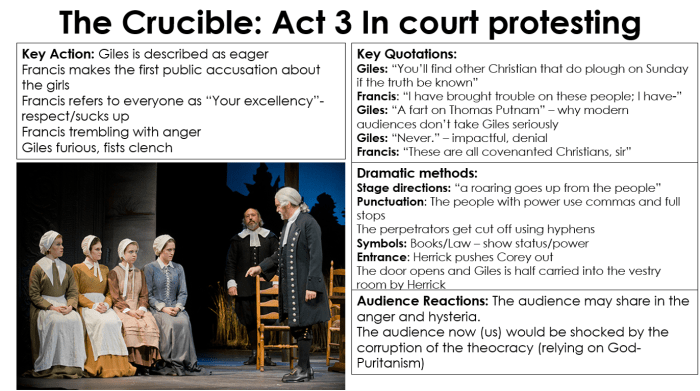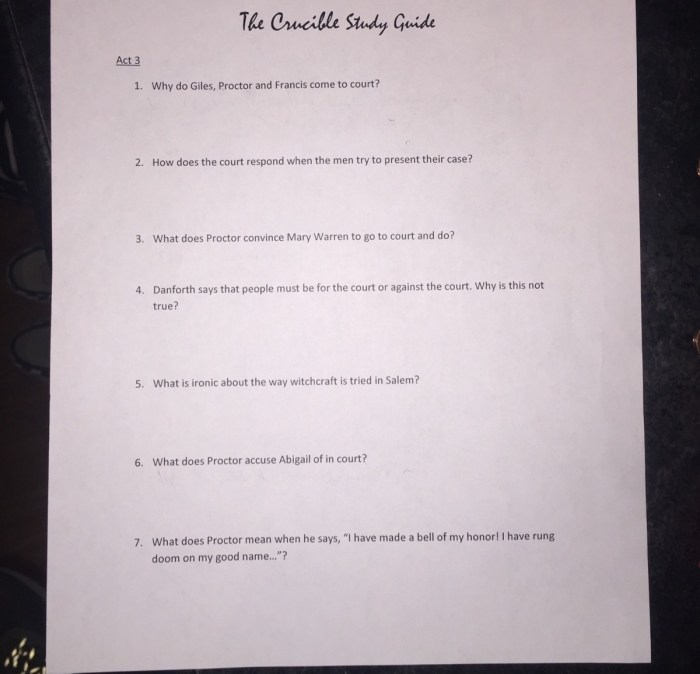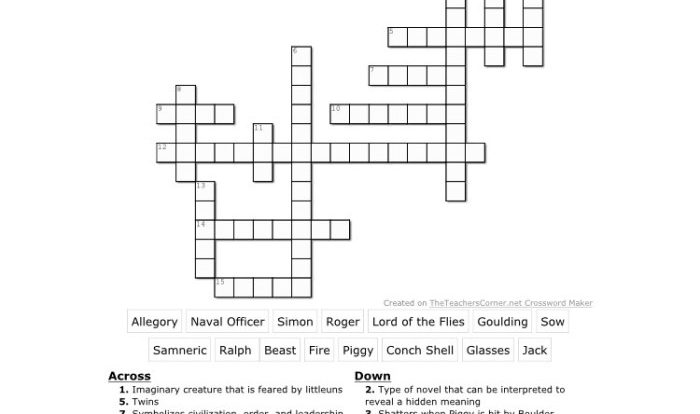Crucible study guide act 4 – Embark on a journey through Act 4 of Arthur Miller’s “The Crucible,” where the stakes escalate, secrets unravel, and the pursuit of justice collides with personal sacrifice. Dive into this captivating study guide that illuminates the play’s intricate themes, character development, and historical significance.
As the accusations and hysteria intensify, Act 4 serves as a pivotal turning point in the narrative, where the characters’ true nature is tested and the consequences of their actions become undeniable.
Key Events in Act 4
Act 4 of “The Crucible” is a turning point in the play. The events that unfold set the stage for the tragic conclusion.
Climax of the Act, Crucible study guide act 4
The climax of Act 4 occurs when John Proctor confronts Abigail Williams in court. Proctor reveals Abigail’s true nature and exposes her lies, leading to her downfall and the eventual collapse of the witch trials.
Other Key Events
- Giles Corey is pressed to death for refusing to testify against his fellow villagers.
- Reverend Parris is arrested for fraud and his role in the witch trials.
- Elizabeth Proctor is arrested and charged with witchcraft.
- John Proctor is tortured in an attempt to force him to confess.
Character Development

In Act 4, Abigail Williams’s character undergoes significant development as her motivations and actions shift dramatically. Initially driven by her desire for John Proctor, she gradually realizes the consequences of her accusations and the extent of her own guilt.
Abigail’s Shifting Motivations
Throughout the act, Abigail’s primary motivation shifts from seeking revenge against John Proctor to preserving her own safety. Initially, she is consumed by her unrequited love for John and seeks to eliminate Elizabeth, his wife, as an obstacle to their relationship.
However, as the trials intensify and the consequences of her accusations become more severe, Abigail’s self-preservation becomes her paramount concern. She realizes that her lies have put her in danger and desperately attempts to escape the consequences.
Abigail’s Desperate Actions
Abigail’s desperation leads her to engage in increasingly desperate actions. She attempts to convince Mary Warren to retract her testimony, even resorting to physical violence when Mary refuses. She also tries to flee the town with Mercy Lewis, but is apprehended by the authorities.
These actions demonstrate Abigail’s willingness to go to any lengths to protect herself, even if it means harming others. Her desperation and self-serving nature ultimately lead to her downfall.
Themes and Symbolism

Act 4 of “The Crucible” delves deeper into the themes and symbolism that have been developing throughout the play.
Major Themes
- Mass Hysteria and Mob Mentality:The witch hunt intensifies, fueled by fear, superstition, and the need for scapegoats.
- The Corruption of Justice:The legal system is manipulated to serve the interests of the powerful, leading to unjust accusations and executions.
- The Power of Truth and Conscience:Despite the overwhelming pressure to conform, individuals like John Proctor struggle to uphold their beliefs and speak out against injustice.
Symbolism
- The Forest:A place of both danger and sanctuary, where the accused witches seek refuge but also face persecution.
- The Birds:Symbols of freedom and innocence, whose absence during the witch trials signifies the loss of hope and the silencing of dissent.
- The Black Cat:A symbol of the devil, associated with Abigail Williams and her evil intentions.
Dramatic Structure

Act 4 of The Crucibleis a pivotal point in the play’s narrative arc, characterized by heightened tension, intense conflict, and a resolution that sets the stage for the tragic climax.
Structure of Act 4
The act begins with the trials reaching their peak, as the accusations and hysteria spread throughout Salem. The tension is palpable as the accused are brought before the court, their fates hanging in the balance.
The conflict escalates when John Proctor confronts Judge Danforth, challenging the legitimacy of the trials. This confrontation leads to a dramatic showdown, in which Proctor’s integrity and the court’s authority are put to the test.
The resolution comes in the form of Abigail Williams’s confession, which reveals the true nature of her accusations. However, this confession is not enough to stop the witch hunt, as the court remains determined to punish those it has accused.
Contribution to the Narrative Arc
Act 4 is a turning point in the play, as it marks the point at which the witch hunt reaches its peak and begins to unravel. The tension and conflict of the act foreshadow the tragic events that are to come, while the resolution sets the stage for the final confrontation between Proctor and the court.
Character Interactions: Crucible Study Guide Act 4
In Act 4 of The Crucible, the interactions between John and Elizabeth Proctor are strained and fraught with tension.
John’s admission of his affair with Abigail Williams has shattered Elizabeth’s trust and broken her heart. She is unable to forgive him and struggles to reconcile the man she knew with the one who has betrayed her.
John Proctor’s Actions
John is desperate to regain Elizabeth’s love and trust. He pleads with her to forgive him and tries to explain his actions. However, Elizabeth is unable to let go of the pain and anger she feels.
John’s actions become increasingly desperate as he tries to prove his innocence. He confesses to his affair with Abigail in court, hoping that it will clear his name and restore his reputation.
Crucible study guide act 4 offers insights into the play’s themes and characters. If you’re interested in exploring other works by Arthur Miller, check out “Los Pinero de Nueva York” here . This 1966 play delves into the lives of Puerto Rican immigrants in New York City, providing a unique perspective on the American immigrant experience.
Returning to Crucible study guide act 4, the guide provides a detailed analysis of the play’s climax and its impact on the characters.
Elizabeth Proctor’s Response
Elizabeth is torn between her love for John and her own sense of justice. She cannot forgive him for his infidelity, but she also knows that he is innocent of the charges against him.
In the end, Elizabeth chooses to support John in his fight against the court. She knows that he is a good man who has made a mistake, and she is determined to help him clear his name.
Historical Context

The Salem witch trials were a dark period in American history that took place in the late 17th century. In 1692, a group of young women in Salem, Massachusetts, accused several members of the community of witchcraft. The accusations quickly spread, and soon dozens of people were arrested and imprisoned.
Nineteen people were hanged, and one man was pressed to death with stones.The Salem witch trials had a profound impact on American society. They led to a widespread fear of witchcraft and a loss of trust in the legal system.
The trials also raised questions about the nature of truth and justice.Arthur Miller’s play The Crucibleis a fictionalized account of the Salem witch trials. Miller wrote the play in the 1950s, during the McCarthy era. McCarthyism was a period of political repression in the United States, during which many people were accused of being communists without evidence.
Miller wrote The Crucibleas an allegory of McCarthyism, and the play’s themes of mass hysteria, guilt, and the search for truth are still relevant today.
The Salem Witch Trials and The Crucible
The Salem witch trials influenced The Cruciblein several ways. First, the play’s plot is based on the historical events of the trials. Second, the play’s characters are based on real people who were involved in the trials. Third, the play’s themes of mass hysteria, guilt, and the search for truth are all explored in the context of the trials.The
Salem witch trials were a tragedy that resulted in the deaths of innocent people. Miller’s play The Crucibleis a powerful reminder of the dangers of mass hysteria and the importance of due process of law.
Essential FAQs
What is the significance of the confrontation between John Proctor and Abigail Williams in Act 4?
This confrontation serves as a pivotal moment in the play, as Proctor confronts Abigail’s lies and attempts to expose her true nature. It highlights the struggle between truth and deception and the consequences of standing up for what is right.
How does the use of symbolism contribute to the themes explored in Act 4?
Miller employs various symbols throughout the act, such as the fire and the forest, to represent the destructive nature of the witch trials and the darkness that consumes the community. These symbols enhance the play’s exploration of themes such as mass hysteria, guilt, and the search for redemption.

